Vol 4 No. 2 TROPIC LIGHTNING NEWS January 13, 1969
Index
Stun NVA Battalion
Triple Deuce, Arty Stop Ambushers
DAU TIENG
- Infantrymen of the 3d Brigade turned the tables on an enemy ambush attempt
against a convoy, killing at least 73 of the attackers.
Artillery fire support and
the quick reactions of Bravo Company, 2nd Battalion (Mechanized), 22d Infantry,
were credited with saving the convoy from being overrun near the edge of the Ben
Cui Rubber Plantation, 45 miles northwest of Saigon.
The convoy was enroute from
Cu Chi to Dau Tieng, base camp of the Tropic Lightning's 3d Brigade, when it
came under intense mortar and rocket attack from an estimated North Vietnamese
battalion.
A crater blocked off Route
239 as a large force opened up from wood lines on both sides of the road with
small arms and rocket grenade fire.
"My artillery observer and
I were flying overhead when he spotted their mortar position and about 50 enemy
soldiers coming through a clearing," said Lieutenant Colonel Ralph M. Cline of
Rockville, Md., Triple Deuce battalion commander.
The forward observer, First
Lieutenant Sam R. Watkins of Greenwich, Conn., called for immediate fire support
from Alpha Battery, 2d Battalion, 77th Artillery.
The Up Tight cannoneers
immediately began pouring fire onto coordinates radioed by Watkins, disrupting
the enemy advance.
"Watkins showed great
proficiency and coolness," said Cline. "The
artillery fire was right on the money and arrived in less than two minutes."
Meanwhile armored personnel
carriers of Bravo Company of the "Triple Deuce" came charging up the road
from a stronghold position, arriving on the scene of the ambush in less than
five minutes.
With the command track of
First Lieutenant John O'Farrell, the company commander, taking the lead, the
mechanized infantrymen rolled around a burning truck and pushed into heavy grass
on one side of the road.
"Suddenly enemy soldiers
were popping up all around us," said Sergeant Luin Amsden of Ellington, Mo.
More than 35 enemy were killed as the mechanized infantrymen opened up
with machine guns and rifle fire, backed by 40mm cannon fire of two Dusters
provided by Bravo Battery, 5th Battalion, 2d Artillery.
As the Triple Deuce men
swept both sides of the road, O'Farrell, of Philadelphia, Pa., spotted a
slightly wounded enemy who was playing dead.
"Three of us saw him lean back to throw a grenade," said Specialist 4
Michael Martz of Hartford City, Ind., O'Farrell's radio operator. O'Farrell and the others blasted
(Continued on Back Page)
Manchus
Halt VC Regiment
By 1LT Mack
Gooding
TAY
NINH
- Patrol Base Mole City, nine and a half miles south of Tay Ninh City, was hit
with a massive ground assault during the early morning hours of December 22,
1968, by the 272d Regiment of the 9th NVA Division.
During the battle, the 4th Battalion of the 9th Infantry Manchus killed
106 enemy.
Patrol Base Mole is located
in an area that has been untouched by allied ground forces for over a year and
is in the middle of one of the most used infiltration routes in the III Corps
tactical zone for NVA units coming into South Vietnam from what is termed the
Angel's Wing sector of Cambodia.
The attack began shortly
after midnight with a fierce mortar, 75mm recoilless rifle and RPG attack which
was followed immediately by a heavy concentration of small arms and automatic
weapons fire. "The mortars were
coming in so fast you would swear that they were automatic," said Private
First Class Walter Schmiel, a grenadier with Bravo Company from Niagara Falls,
N.Y.
"Approximately 15
minutes after my listening post spotted movement, the ground attack started on
Charlie Company's front. Mortars,
continued to come in along with RPGs. We
got them to my front and to the south. Tracers,
ours and theirs, were going everywhere in the perimeter. After a few minutes we got our artillery coming to the front
of Charlie Company and not long after that gunships and the air strikes.
We had all the help in the world we could get."
This is the way the battle began according to First Lieutenant Wilbur D.
Saulters, a platoon leader with Bravo Company from Carson, Miss.
The battle continued for
seven hours, with the NVA penetrating the trenchline between two bunkers.
Once the enemy troops were in the trench, they were picked off by Manchu
marksmen.
The Manchus' commanding
officer, Lieutenant Colonel Lee L. Wilson from Salina, Kans., had supervised the
construction of Mole City four days earlier and was certain that the base could
withstand any assault. "The enemy
threw everything they had at us, and we threw everything we had right back at
them," said Wilson. A human-wave
attack was repulsed by the valiant Manchus by laying down a massive field on
fire. So heavy was the volume of
fire that four M-60 machine gun barrels melted down completely.
"Air strikes were right on
station after the contact commenced" said Captain Richard E. Foulk, the
Manchus' S-2 officer from Twin Falls, Idaho.
(Continued
on Back Page)
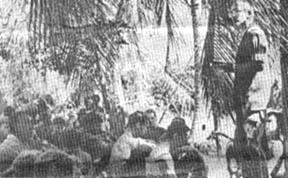 |
SERVICE WITH A MEANING - Fourth Battalion, 9th Infantry Chaplain Captain William F. Hoehne of Spokane, Wash., conducts a field service at Mole City just hours after the estimated enemy regimental-size assault was defeated by the hard-fighting Manchus. (PHOTO BY PFC H. J. TSCHIRNER) |
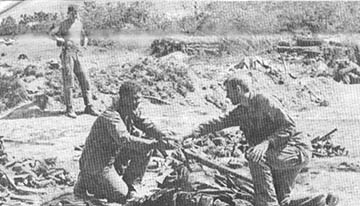 |
| LOST AND FOUND - Private First Class Thomas H. Maddox of New Madrid, Mo., and Private First Class Bob B. Chavous of Perkase, Pa., both assigned to Bravo Company, 4th Battalion, 9th Infantry, prepare bundles of weapons captured during the unsuccessful estimated regimental-sized enemy assault on Patrol Base Mole City defended by the Manchus. The Tropic Lightning soldiers killed 106 of the enemy. (PHOTO BY PFC H. J. TSCHIRNER) |
Near
Trang Bang Bobcat Week Busy
In a week of heavy fighting
Fire Brigade soldiers from the 1st Battalion (Mechanized), 5th Infantry, killed
56 enemy during operations in the Ho Bo woods.
On December 8 the Bobcat's
Alpha and Charlie companies were sweeping near their night location when they
received small arms and RPG fire from an estimated enemy company.
During the brief fight that followed, the Bobcats killed two VC.
One RPG-2 launcher with 11 rounds, three AK-47s and documents were
captured in the action.
The following day, Alpha
Company, while sweeping, received small arms and automatic weapons fire.
The combined force of infantry, artillery and air strikes accounted for
14 NVA bodies, one light machine gun, two RPG-2 launchers, two AK-47s and one
wallet.
On the same night a Bravo
Company ambush opened up on eight VC, killing two.
Blood trails were discovered in an afternoon sweep.
During the morning of 11th
Charlie Company, first of the fifth, engaged three armed NVA soldiers, killing
them and capturing their RPG-7 launcher and light machine gun.
Later that same day, Alpha
Company soldiers engaged two VC killing them and uncovering a base camp.
While searching the complex, one suspect was detained.
The detainees told the 2d
Brigade soldiers that there were VC hiding in 30 nearby spider holes.
The concealed enemy opened up on the Tropic Lightning soldiers.
(Continued
on Back Page)
Page 2 TROPIC LIGHTNING NEWS January 13, 1969
Decorated
| ARMY
COMMENDATION MEDAL
(HEROISM) |
|
| LTC
Andrew H. Anderson, HHC, 1st Bn, 5th Inf MAJ Cain A. Bridgman, C Co, 4th Bn, 23d Inf CPT Edward Mikita, A Co, 2d Bn, 22d Inf CPT Keith A. Wilks, B Co, 2d Bn, 14th Inf CPT George G. Reese, B Co, 25th Avn Bn CPT Larry C. Anderson, HHC, 2d Bn, 12th Inf CPT Thomas A. Cindric, C Btry, 1st Bn, 8th Arty CPT Edward C. Schillo, D Co, 2d Bn, 12th Inf 1LT James D. McKinna, HHC, 2d Bn, 27th Inf 1LT Ronnie Q. Jones, A Co, 2d Bn, 27th Inf 1LT William G. Cirincione, D Trp, 3d Sqdn, 4th Cav CSM Paul H. Saft, HHC, 2d Bn, 14th Inf SFC Arthur M. Howe, Co A, 2d Bn, 14th Inf SFC Walter H. Langley, HHC, 4th Bn, 23d Inf SFC Robert Nelson, D Co, 3d Bn, 22d Inf SSG Jose R. Acosta, C Co, 65th Engr Bn SSG Ben Marzec, C Co, 2d Bn, 14th Inf SSG Stephen B. Duerk, B Co, 1st Bn, 5th Inf SGT James M. Streeter, A Co, 2d Bn, 27th Inf SGT Brannen E. Edwards, A Co, 2d Bn, 27th Inf SGT Gerald P. Coffey, A Co, 2d Bn, 27th Inf SGT Larry D. Southerland, HHC, 1st Bde SGT Dennis J. Rushing, C Co, 3d Bn, 22d Inf SGT Larry G. Worzella, C Trp, 3d Sqdn, 4th Cav SP5 Bruce D. Paulsen, C Trp, 3d Sqdn, 4th Cav SP4 Leroy Zeno, A Btry, 3d Bn, 13th Arty SP4 Stephen R. Heberling, C Trp, 3d Sqdn, 4th Cav SP4 Kenneth L. Baus, A Btry, 7th Bn, 11th Arty SP4 Charles M. De Bruhl, C Co, 1st Bn, 5th Inf SP4 Jeff L. Land, C Co, 1st Bn, 5th Inf SP4 George Chambers, C Btry, 2d Bn, 77th Arty SP4 Ignaius Castaldo, C Btry, 2d Bn, 77th Arty SP4 Gary R. Cruse, D Co, 2d Bn, 27th Inf SP4 Harry Jordan, C Co, 3d Bn, 22d Inf SP4 Bruce A. Potter, C Trp, 3d Sqdn, 4th Cav |
SP4
James Turnage, HHC, 3d Bn, 22d Inf SP4 Winston Guillory, C Trp, 3d Sqdn, 4th Cav SP4 Ronald W. Demontmollin, C Trp, 3d Sqdn, 4th Cav SP4 Richard V. Heumier, C Co, 2d Bn, 14th Inf PFC Charles M. Wyatt, C Co, 4th Bn, 23d Inf PFC Stanley D. Hester, A Btry, 3d Bn, 13th Arty PFC Larry J. Folkerts, A Btry, 3d Bn, 13th Arty PFC Douglas W. Kramer, D Co, 1st Bn, 5th Inf PFC Anson L. Smith, A Btry, 7th Bn, 11th Arty PFC Robert L. Dane, A Btry, 3d Bn, 13th Arty PFC Melvin R. Moore, A Trp, 3d Sqdn, 4th Cav PFC Bobby L Smith, A Co, 2d Bn, 27th Inf PFC Benjamin Dunbar, A Co, 2d Bn, 27th Inf PFC Joseph W. Peace, A Co, 2d Bn, 27th Inf PFC Martin Espinoza, D Co, 3d Bn, 22d Inf PFC Willie B. Jacobs, A Co, 2d Bn, 27th Inf PFC Floyd L. Steward, A Co, 2d Bn, 27th Inf PFC Richard L. Jaquays, A Co, 2d Bn, 27th Inf PFC Darryl Brown, A Co, 2d Bn, 27th Inf PFC Hiroshi Baba, C Co, 65th Engr Bn PFC Dave L. Van Agtmael, C Co, 65th Engr Bn PFC Theodore Combs Jr., A Co, 2d Bn, 27th Inf PFC Edward B. Spear, D Co, 2d Bn, 27th Inf PFC James W. Peden, B Co, 2d Bn, 12th Inf PFC Leroy R. Rivers, C Co, 3d Bn, 22d Inf PFC Hollis Lamar, C Co, 3d Bn, 22d Inf PFC Sherrell Leavins, D Co, 2d Bn, 27th Inf PFC Rex A. Yarian, D Co, 3d Bn, 22d Inf PFC Ronald Timock, D Co, 2d Bn, 27th Inf PFC Joseph A. Mack, Co, 3d Bn, 22d Inf PFC Thomas Scally, D Co, 2d Bn, 27th Inf PFC Edward L. Jones, B Co, 2d Bn, 12th Inf PFC Thomas E. Brown, A Co, 1st Bn, 27th Inf PFC Kenneth E. Mullin, C Co, 3d Bn, 22d Inf |
Every
Soldier Should Know Where To Go For Assistance
Did you ever have a pressing
problem that you couldn't solve by yourself?
Where did you go for help? With
whom did you speak?
In the spite of the Army's
effort to keep its people well informed, many soldiers just don't know what to
do when they run into this sort of situation.
In many cases, just not
knowing where to turn for help can result in the soldier getting the WRONG
information.
Virtually every problem,
regardless of its nature, should be first taken to your unit commander.
He is interested in you because he is responsible for the well-being of
his command. If he cannot provide
you an answer or solve your problem, he will direct it to the proper
authorities.
Every problem has its
appropriate source of resolution within the military establishment.
For legal questions, there is the Staff Judge Advocate; for questions
about finance there is the finance officer; for character guidance or religious
problems there is the chaplain; for
administrative questions about some phase of your career there is the personnel
officer; for emergencies, the American Red Cross is available.
In addition to these and
other specialized agencies there is the Inspector General Complaints System,
which has the basic purpose of correcting injustices affecting individuals and
of eliminating conditions determined to be detrimental to the efficiency or
reputation of the Army.
You have the right to
register complaints orally or in writing with an inspector general.
While you are not required to submit to an interview by anyone prior to
registering a complaint, it is recommended that you first discuss your problem
with your unit commander. In any
event, it is necessary to obtain permission to be absent from your place of duty
to visit an inspector general.
Inspectors general will act
promptly on your complaint, request for assistance, or request for information
and will advise you of the action taken in connection with your request for
inspector general action.
Remember that you and your
dependents will save time and have your problems resolved more expeditiously by
contacting the proper personnel or agency.
So don't forget that you
have some say in numerous matters that affect you personally in the military.
It is not only your right, but your duty to bring legitimate grievances
to the attention of the proper authorities.
The whole thing is aimed at keeping the rights of the individual soldier
uppermost in the minds of commanders.
Problems have a habit of
cropping up when you least expect them. You
can be prepared to meet obstacles by knowing to whom your grievance or request
goes to.
Whenever
You're Ready GI BILL Can Assist You
Want schooling after your
time in the service is up? Here are
a few helpful hints to let you know how the GI Bill can assist you in meeting
the rising costs of education. When
you receive your honorable discharge, look what is available to you!
You are eligible to receive
financial assistance to (a) obtain education which you otherwise might not have
been able to afford; (b) resume the educational activities which were
interrupted by your military service; or (c) further your education or advance
your vocational status.
For each month or fraction
of a month you serve on active duty, you can receive one month of financial
assistance, up to a maximum of 36 months or its equivalent if your studies are
on a part-time basis. The money is
paid directly to you. You must pay
all expenses and whatever tuition is involved.
Educational institutions
approved for study both inside and outside the U.S. include public or private
secondary schools; junior colleges and teachers' colleges; professional,
scientific and technical schools and four year colleges and universities.
Financial assistance is also
available to veterans for approved apprenticeship, on-the-job training, or farm
or flight training programs.
Your eligibility for these
benefits ends eight years after your last release from active duty.
This means that you must arrange your program of studies so that it will
be completed before you reach the eight-year limit.
Take advantage of this
opportunity. These laws express
your country's appreciation for your service and assure you of opportunities
which you might not have had if you never entered the Armed Forces.
Whether you take advantage
of these benefits is, of course, your choice.
But the opportunity is there.
YEARBOOK!
The 25th Infantry Division's 1968 Yearbook has been printed and was
placed in the mail in late December. A limited
quantity of the books are still available through the publisher on a first-come,
first-served basis. Persons wishing
to purchase a yearbook should send a check or money order to Albert Love
Enterprises, Inc., Post Office Box 1000, 3101 McCall Drive, Doraville, Georgia,
30040.
Tropic Lightning
Combat Honor Roll
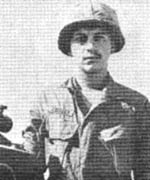 Added to this week's Combat Honor Roll is Corporal Anthony
M. Logallo of C Battery, 1st Battalion, 8th Artillery.
Logallo distinguished himself by heroic actions on November 8, 1968.
A numerically superior communist force launched a massive mortar, rocket,
and ground assault against Fire Support Base Keene.
Added to this week's Combat Honor Roll is Corporal Anthony
M. Logallo of C Battery, 1st Battalion, 8th Artillery.
Logallo distinguished himself by heroic actions on November 8, 1968.
A numerically superior communist force launched a massive mortar, rocket,
and ground assault against Fire Support Base Keene.
During the
initial contact, the sixth howitzer section sustained a direct hit, knocking
Logallo to the ground.
Although Viet Cong
projectiles continued to saturate the area, he dauntlessly moved to his howitzer
and loaded a round. Disregarding
his own safety, he exposed himself to a heavy volume of fire to secure fuzes and
projectiles for countermortar fire.
His valorous actions
contributed immeasurably to the thwarting of the aggressor's assault.
His personal bravery, aggressiveness, and devotion to duty are in keeping
with the highest traditions of the military service and reflect great credit
upon himself, his unit, the 25th Infantry Division and the United States Army.
The TROPIC LIGHTNING NEWS is an authorized publication of the 25th Infantry Division. It is published weekly for all division units in the Republic of Vietnam by the Information Office, 25th Infantry Division, APO San Francisco 96225. Army News Features, Army Photo Features, Armed Forces Press Service and Armed Forces News Bureau material are used. Views and opinions expressed are not necessarily those of the Department of the Army. Printed in Tokyo, Japan, by Pacific Stars and Stripes.
MG Ellis W. Williamson . . . . Commanding General
MAJ Andrew J. Sullivan . . . Information Officer
2LT Don A. Eriksson . . . . . . Officer-in-Charge
SP4 Stephen Lochen . . . . . . Editor
SP4 Robert C. Imler . . . . . . . . Assistant Editor
SP4 Tom Quinn . . . . . . . . . . . Production Supervisor
Page 3 TROPIC LIGHTNING NEWS January 13, 1969
Wolfhounds
Fire, & Break VC Attack On FSB Mahone
DAU
TIENG
- Wolfhounds of the 1st Battalion, 27th Infantry, repelled an enemy rocket and
mortar attack against Fire Support Base Mahone.
Six dead enemy were found the following morning.
The enemy struck at twilight
from three sides of the 3d Brigade support base, which is located in the
trapezoid 38 miles northwest of Saigon.
Approximately 100 mortars
and RPG rounds struck the base. "We
were alert to the possibility that they would try a ground attack," said
Sergeant Roy A. Everett of the Bronx, N.Y., who is in charge of a mortar
platoon.
"Although our first
reaction was to seek shelter in a bunker until the mortars let up, we went out
and began firing counter mortar fire."
Despite mortars and
fragments landing around their positions, Wolfhound mortarmen fought back,
pumping out more than 800 rounds during the night.
At the height of the attack,
many of the mortarmen were forced to lie flat on the ground around their tubes
as they fuzed projectiles to send hurtling toward the enemy.
Meanwhile riflemen around
the perimeter of the camp sent thousands of rounds of rifle and machinegun fire
toward the enemy soldiers. The
attack was broken in little more than an hour, as the enemy force withdrew
through treelines on both sides of the hamlet of Thanh An.
Meanwhile artillery from
Fire Support Base Wood and from Dau Tieng base camp poured explosives on the
retreating enemy. Charlie Battery
of the Up Tight 2d Battalion, 77th Artillery, in Mahone sent out more than 900
rounds.
After the battle, Lieutenant
Colonel Mark L. Resse of Kansas City, Mo., Wolfhound battalion commander,
praised the way his men broke the attack.
"I am extremely pleased by
the way the men reacted. They did a tremendous job," he said.
The following morning Bravo
Company swept the area and discovered the six enemy dead. At the same time Reese was flying overhead in an effort to
discover exactly where the enemy had emplaced his mortar tubes.
Hovering in a light
observation helicopter piloted by First Lieutenant L.E. Campbell of Muskogee,
Okla., Reese spotted three steel plates in heavy vegetation below.
Not waiting for his
infantrymen to secure the area, the battalion commander and his pilot set down
twice and picked up the plates, which were needed for evaluation.
"My pilot showed great
courage in setting down in these areas without benefit of a securing force,"
noted Reese.
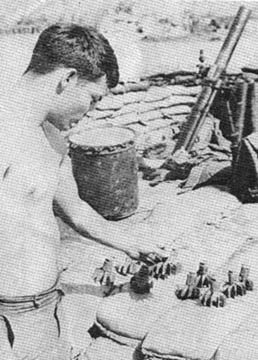 |
FOLLOWING MORE than 100 enemy mortar and rocket rounds fired against Fire Support Base Mahone 38 miles northwest of Saigon, Private First Class Les Watkins of Nedosha, Kans., an ammo bearer, looks at some of 17 tail sections from mortars which landed around his position. Watkins and other gunners of the 1st Battalion, 27th Infantry, Wolfhounds mortar platoons kept firing during the height of the attack to help break the enemy probe. Six enemy soldiers were killed. (PHOTO BY SP4 HECTOR NADAL) |
Bird
Dog Flies Past 10,000 Hour Mark
By 1LT Mack D.
Gooding
TAY
NINH -
A 17-year-old O-1 Bird Dog, a light observation airplane, recently broke the
usual mark of 10,000 air hours and still has 'spirit' for the Tactical Air
Control Party (TACP) attached to the 1st Brigade.
Captain Walter Lehman of
Phoenix, who flew the Bird Dog past the milestone, gave an explanation of what
this meant. He stated, "If you
were to drive your car around the world thirty times or 750,000 miles this would
be the amount of wear and tear that this aircraft has been through."
Within the 1st
Brigade, the U.S. Air Force TACP uses this aircraft for finding and marking
positions for air strikes.
Major Everett E. Prichard of
Waycross, Ga., who serves as liason officer of the TACP at Tay Ninh West
airfield commented, "If we had a Hall of Fame for airplanes I feel sure this
particular Bird Dog would be right there."
The O-1 Bird Dogs presently
assigned to the 1st Brigade TACP are due to be supplemented with several new,
twin engine OV-l0s later this month. "Even
though we're getting in new OV-l0s, the O-1 Bird Dog is a great little
airplane," said Prichard. "I
hope the OV-l0s can stand the test of time as well as the Bird Dog has."
Combat
Tracker Team Finds Enemy Weapons, Hoi Chanh
CU
CHI -
A Tropic Lightning Combat Tracker Team from the 66th Infantry Platoon recently
brought in an assortment of enemy weapons and a Hoi Chanh in action at Trung
Lap, five miles northwest of Cu Chi.
The team, with their scout
dogs were called in by Alpha and Charlie companies of the 1st Battalion
(Mechanized), 5th Infantry, to sweep the area around their night laager.
Earlier that morning, the infantrymen had undergone a fierce RPG barrage.
The team arrived at the site
at 8 a.m. and immediately began the sweep in heavy undergrowth.
The terrain was rough, but the dogs led the men to blood and foot trails
left by a retreating, hurting enemy.
Sergeant Michael P. Landers
of Auburn, Ill., the track platoon leader, related that pay dirt lay just
outside the site.
"I sent my visual track to
the front. They found a lot of
tracks. Everyone had scattered.
They usually do when they are beaten back.
It's supposed to help them avoid detection," cited Landers.
Landers continued, "The
tracks led to a trench line. We
followed them until they split up, one going east and one south."
The sergeant sent his visual
track east to follow the trench. Landers
proceeded south to follow blood trails. As
he proceeded, the visual track was busy collecting web gear and miscellaneous
equipment. The rest of the way they
fired into areas of possible enemy concentrations.
Meanwhile, Landers' dogs
had led them to signs of heavy movement. "We
had proceeded for about 300 meters when we came upon a hootch.
We drew AK-47 fire from a sniper. We
moved through the hootch and found blood trails.
Our support was sweeping in our direction and when we met them they had a
Hoi Chanh with them."
A sweep to the east revealed
three AK-47 rifles, numerous Chicom grenades, 57mm recoilless rifle rounds and
RPG-2 rounds with launchers.
"The way dogs operate is
the most impressive thing about the tracker business.
They are lightning fast, extremely sensitive and downright smart.
I have all the faith in the world in them," concluded Landers.
Platoon Sergeant Robert
Northrup of West St. Paul, Minn., related that the arrival of scout dog teams in
Vietnam brought a weapon as good as anything that shoots.
"Three hundred meters away
and you know Charlie's there. There's
no doubt about it; the dog knows what he is after.
He can do one thing better than us - use his nose and ears to locate the
enemy."
| MEDICAL HELP FOR CHARLIE - Company commander Captain Wayne A. Downing of Peoria, Ill., from Alpha Company, 2d Battalion, 14th Infantry, watches intently as SP4 Dennis Murphy of Garden City, Mich., administers medical aid to a wounded Vietnamese. The suspected enemy was wounded in a Tropic Lightning ambush. (PHOTO BY SP4 E. R. JAMES) | 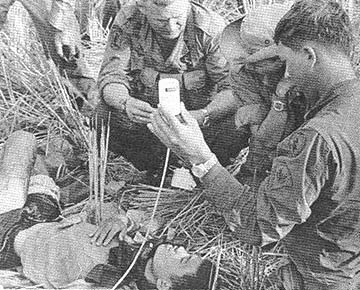 |
Page 4-5 TROPIC LIGHTNING NEWS January 13, 1969
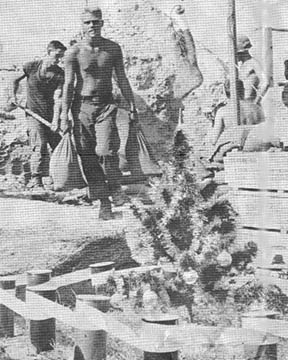 |
|
||||||
| A TREE GROWS IN WASHINGTON - A Christmas tree was added to Fire Support Base Washington for the holiday season. The tree belongs to the 7th Battalion, 11th Artillery. | AND WHAT DID YOU GET FOR CHRISTMAS? - Troops high atop Nui Ba Den were the first troops in Vietnam to receive their 1968 Christmas Ditty Bags from the Red Cross. The 1st Brigade men eagerly rifling their bags to see what they got are, left to right, Specialist 4 Larry DeShazer of Houston, Tex., Private First Class Clyde Brooks of Franklin, La., Private First Class Ron Hunter of Jonesboro, Ark., and Private First Class John Deckard of San Diego, Calif. (PHOTO BY 1LT MACK D. GOODING) |
Christmas
For Tropic Lightning
A conventional Christmas was
not on the agenda for the men of the Tropic Lightning Division this year.
Instead of Christmas in Connecticut or Illinois or Texas, the holidays
were celebrated in Vietnam.
Instead of the familiar
sights and sounds that herald the approach of the season to be jolly, the combat
troopers hear the crack of artillery fire and the irregular sound of automatic
weapons laying down a base of fire.
On hand to ring in Christmas
with the troops were mosquitoes, snakes and other notorious creatures of
Southeast Asia. Men accustomed to
walking knee deep in snow on their way to spend Christmas Day with friends and
relatives, walked ankle deep in dust, a familiar by-product of the dry season.
But Christmas did come to
the 25th Infantry Division. Billy
Graham brought consolation and reassurance for heavy hearts;
the Red Cross Girls - bright smiles and Christmas carols.
And there was Hope - a lot of laughs, beautiful girls, great
entertainment, the sharp Hope with the States on parade in Vietnam.
Troops in the field during
the holidays had quite a few welcome visitors for a change.
With Billy Graham, the famous evangelist, came remembrance of the true
meaning of Christmas as he flew into fire support bases around III Corps.
The troops were anxious to have a few words with Dr. Graham.
It was a real experience just to say 'hello.'
Doughnut Dollies, those
ever-lovin' gals from the Red Cross covered a lot of ground, from Keene to the
top of Nui Ba Den, leading the troops in Christmas carols. Let it never be said that a Red Cross girl isn't
everyone's girl friend.
The Red Cross made it a
point to make Christmas a meaningful day. Ditty
bags came from the States. They
contained items of use to anyone in Vietnam: playing cards, stationery, pen
lights, chewing gum, fountain pens and candy.
Each soldier knew that those back home know he is here and appreciate it.
Hope? You bet there was. Starting
with the prayers of those who attended church services that dark Christmas Eve,
whether in base camp or in small groups in the field, the hope for peace and a
safe return home were dreamed on. Then
Hope sprang to life before our eyes in the shape on that famous comedian, the
GI's Santa Claus, and his troupe at the Lightning Bowl before 15,000 cheering
soldiers.
Beautiful round-eyed women;
Honey Limited, the Golddiggers, Miss World Penelope Plummer and Ann-Margret
captured thousands of eyes. Big
Roosevelt Grier belted out songs and trampoline champion Dick Albers bounced as
high as the happiness all around. Bob
Hope himself, complete with giant Lightning patch, added all that could be
included to round out the show.
The soldiers of the 25th are
grateful to those who went out of their way to bring the spirit of Christmas to
Tropic Lightning country and help share an unconventional but thankful
Christmas.
| CAROLS - Red Cross girls and other volunteers brought a traditional touch to Christmas by going caroling to Tropic Lightning's fire support bases Christmas day. (PHOTO BY SP4 LARRY WEIST) | 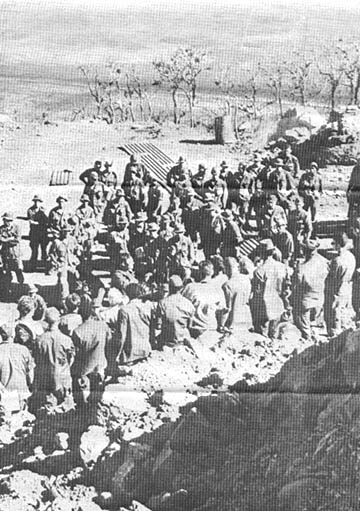 |
And, Of Course, There Was Hope
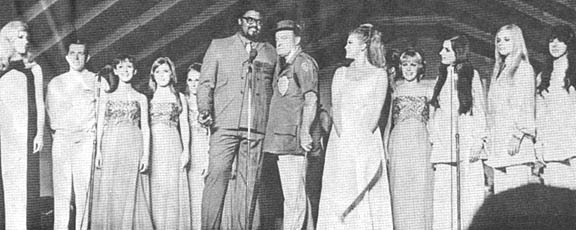 |
|
THE BOB HOPE SHOW - 1969 |
Page 6 TROPIC LIGHTNING NEWS January 13, 1969
Road
Sweeping Is Nicest For Soldiers On Motorcycles
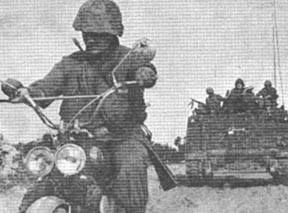 TAY
NINH -
Two Honda 50 motorcycles, formerly owned by the Viet Cong, have been put to good
use by elements of the 1st Brigade. Roads
are now swept for mines more quickly than ever before.
TAY
NINH -
Two Honda 50 motorcycles, formerly owned by the Viet Cong, have been put to good
use by elements of the 1st Brigade. Roads
are now swept for mines more quickly than ever before.
The Hondas are currently
being used to detect enemy road mines, booby traps and trip wires.
By using the Hondas the 1st Brigade is saving valuable time in sweeping
and clearing the roads. During the
monsoon season, the old, time-consuming method of using a sweep team on foot was
necessary. During the dry season,
however, the Hondas provide an opportunity to work faster.
Major General Ellis W.
Williamson came up with the idea and passed it along to Colonel Robert L. Fair,
of San Francisco, Calif., commanding officer of the 1st Brigade, for
implementation. The 4th Battalion
(Mechanized), 23d Infantry was the 'unit' selected to try the Hondas on road
sweeps.
Currently only the two
captured Hondas are being used for the road sweeps, but six more bikes have been
ordered through military supply channels and are being shipped from Japan.
With the Honda roaring down
the road in front of the armored personnel carriers, few mines, booby traps and
trip wires will go undetected.
Use of the Honda has cut the
time required to clear the road considerably.
Company B, 4th Battalion, 23d Infantry, now sweeps the road in one hour,
instead of the three required by the old method.
The driver of the Honda is
an infantryman with prior experience in riding motorcycles.
His attire consists of a helmet, flak jacket and an M-16 rifle.
When a suspicious object is found the driver dismounts and signals for
the demolition team, which scrutinizes the situation and takes the necessary
action.
When asked how he felt about
driving one of the Hondas, Private First Class Dennis Hill of Pico Rivera,
Calif., said, "There is no problem in handling the motorcycle, especially now
in the dry season. This method of
sweeping the road is much easier and faster.
I'm able to cover the same area with the same amount of accuracy in one
third the time it used to take."
Both the 4th Battalion, 23d
Infantry, and Colonel Fair are very pleased with the success of the
road-sweeping Hondas so far.
RAT
PATRQL RIDES AGAIN
- (Above, right) Private First Class Dennis Hall of Los Angeles steers his Honda motorbike
along the road to Fire Support Base Rawlins, clearing the road for his fellow
infantrymen with the 4th Battalion (Mechanized), 23d Infantry.
During South Vietnam's dry season, Tropic Lightning has found that
visual is more efficient than electronic observation
(PHOTO
BY SP4 DAVE JACKSON)
Regulars
Find Cache Hidden Near River
TAY NINH
- While on a reconnaissance-in-force mission seven miles northwest of Tay Ninh,
C Company of the 3d Battalion, 22d Infantry, discovered a weapons and ammunition
cache located on the banks of the Rach Ben Da River.
The 1st Brigade troopers
first realized that there may be something in the area when the keen eyes of
pointman Specialist 4 Ralph E. Wilks of Niles, Mich., spotted an ammunition
container partially exposed in the thicket by the river.
Further inquiry by
Specialist 4 Steve Grippi of Ashtabula, Ohio, and Sergeant Bernard Peralta of
Los Angeles, disclosed three bolt action 30 caliber sniper rifles protected by
spent flare cartridges. Looking
further, they also uncovered several NVA uniforms and a wallet containing
receipts and an identification card.
Immediately after the first
findings, Captain Donald I. Haramoto of Makawao, Maui, Hawaii, set out security
and organized a search team. Several
freshly used sleeping positions were found and an enormous ant hill brought
curiosity into the eyes of one Tropic Lightning infantryman.
Private First Class Randy Kitzen of Richardton, N.D., probed the ant hill
and found an entrance into the mound which had been completely hollowed out.
Searching the cavity, Kitzen found fifty pounds of Russian explosives,
several hundred rounds of small arms ammunition, sandbags, NVA rations and
detonators used for booby traps.
Philadelphia
4th Grade Class Sends PFC A Record 110-Letter Mail Call
| TAY
NINH -
It's lucky for Private First Class Phillip Smith of Philadelphia, Pa., that
Company D, 3d Battalion, 22d Infantry was picked to be the first unit to use the
1st Brigade R&R Center in Tay Ninh - The Holiday Inn. Smith's company came in fresh from combat operations at Fire Support Bases Grant, Bragg and Buell for a well earned two-day stand down. The day before they arrived at the Tay Ninh base Smith received over a hundred letters from his hometown, the City Of Brotherly Love. "My girl teaches a 4th grade class in Philadelphia and her students all wrote a letter to me", said Smith. "Boy, am I flabbergasted." Two were of special interest to Smith. "One little girl promised to wait until she grew up and then marry me because she said I was so big and strong. Another asked me to pray for her and her school soccer team because they had lost their last three games in a row." Smith and his friends plan to answer every letter and to send the class a souvenir from South Vietnam. "We'll probably send a Vietnamese flag," stated Smith. "The class has a collection of flags from around the world and it will help to make their collection something special." PFC Smith suddenly realized that he just couldn't afford any more time for comments to the press. "I just have too much reading to do," he grinned as he started shuffling through his correspondence. |
|
Page 7 TROPIC LIGHTNING NEWS January 13, 1969
LCLC
Makes Professionals
Teaches Tricks Of Trade
CU
CHI -
In the northwest corner of Cu Chi base camp lies a problem-solving organization
available to all commanding officers. It
is known as the Lightning Combat Leaders Course (LCLC), and it strives to
eliminate some of a commander's problems.
Within a few weeks of the
time a commanding officer gains a new man in his unit, this man may display the
qualities of a leader and be placed in the position of a squad or fire-team
leader. With each new experience,
this leader becomes more competent.
But there is a time element.
A man has a 12-month tour; how long will it take for this new leader to
reach his full potential of combat effectiveness, and will he have completed
most of his tour before he attains professionalism?
Lightning Combat Leaders
Course accelerates the process by which a potential leader becomes a reliable
professional. During the nine-day
course, the students are familiarized with nearly every combat situation and are
shown the proper methods of coping with field problems.
LCLC is by no means a
strictly classroom school. Most
classes are conducted out of doors, and the most widely used teaching aid is the
field radio.
After nine days of
instruction, a student has a command of military terms used in field
communications. He must be able to
use the radio quickly to call for artillery support, gunship support and medical
evacuation.
Artillery classes are
conducted on the base camp perimeter line.
After preparatory classes, the student is given the opportunity to call
for, direct, and observe artillery fire.
Written exams
are frequent. By performing well on
these tests and showing leadership qualities during practical exercises, the
LCLC student can be the honor graduate and thus be advanced to the next higher
grade.
The final examination of one
period of the training schedule had greater rewards than a promotion, however.
It is the ambush patrol.
The seventh day at LCLC
finds the students on an actual ambush patrol outside of the Cu Chi base camp.
Lightning Combat Leaders
Course offers another step on the ladder to professionalism.
It gives the graduating student a confident and responsible approach to
weapons, demolition, support fire power, troop maneuvers and tactical decisions.
Even more important, LCLC
gives the student the momentum to make the final step to professionalism -
leadership under fire.
|
STORY
& PHOTOS |
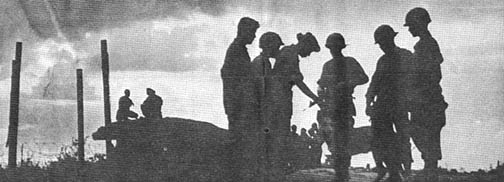 |
| WAITING for the cover of darkness, LCLC students make the final preparations before moving out on an actual night ambush patrol. The night patrol is the final and the most important exercise before graduation. |
Page 8 TROPIC LIGHTNING NEWS January 13, 1969
Lightning
Troops Smile While Mortars Drop Into Pershing
CU
CHI -
When the 2d Brigade's Fire Support Base Pershing received over 100 VC 82mm
mortar rounds and nearly as many RPG projectiles within its perimeter in 20
minutes, everyone reached for his camera instead of his weapon.
Every clicking shutter
seemed to be a little "thank you" to 2d Battalion, 12th Infantry,
squad leader Sergeant Frederick W. Kempster from Washington, D.C., who was the
man responsible for the harmless delivery of the weapons by U.S. Army
helicopter. "We're really proud
of this cache today," said Captain Paul Allen, battalion air operations
officer.
While on eagle flight and
sweep operations in the Ho Bo woods, Kempster spotted several small enemy mortar
charge containers in the bottom of a narrow hole. "I alerted the company, and we stopped and put up security
immediately," said the sergeant. "As
soon as that was done, I turned tunnel rat."
Moving cautiously, the Delta
Company squad leader slipped into a large underground room and quickly returned
with the first of the Communist-made 82mm mortars.
"With security out, we
began searching further in the area and immediately began to turn up more holes
with munitions," said Delta's C.O., Captain James F. Ellis, from Falls
Church, Va. "We also discovered
underground, multilevel living quarters complete with camouflaged concrete
lid," he added.
The huge pile of enemy
munitions which were taken to Fire Support Base Pershing included 128 82mm
mortars, 100 RPG projectiles, and 54 RPG boosters.
The living quarters were destroyed by Tropic Lightning engineers from C
Company, 65th Engineer Battalion.
Ambushers
Stomped....
(Continued
From Page 1)
the enemy soldier, but not before he threw the deadly weapon.
"We were extremely lucky
that the grenade fell short," said Martz.
While the Triple Deuce
infantrymen battled it out with the ambushers, artillery from Fire Support Base
Wood and Mahone and from Tay Ninh and Dau Tieng base camps poured projectiles
onto suspected routes of escape.
The convoy also received
immediate assistance from Air Force air strikes.
Captain Charles McGregor of Detroit, Mich., a forward air controller, was
guiding in an F-100 Supersabre strike less than a mile from the convoy's
position when it was hit.
McGregor diverted the
strike, sending bombs and strafing runs onto a stronghold he spotted less than
400 meters from the beleaguered truckers. More
jets and strafing runs were called in by Captain James J. Hourin of Ellenville,
N.Y.
Cobra helicopters from the
3d Squadron, 4th Cavalry and other 25th Division units poured onto enemy troops
fleeing to the north.
Meanwhile Colonel Louis J.
Schelter Jr. of Columbus, Ga., 3d Brigade commander, sent Charlie Company of the
2d of the 22d to secure a landing zone as Wolfhounds of Bravo Company, 1st
Battalion, 27th Infantry, made an airmobile assault into a clearing less than a
mile from the convoy.
The Wolfhounds, commanded by
Captain Lawrence Rubino of Lynn, Mass., fought an engagement with a force which
was hiding in bunkers. At least 13
enemy were killed by the Wolfhounds.
Sweeps of the battle area
continued for more than a day as the enemy toll continued to mount to 73
confirmed kills.
The
Name Sounds Familiar, Or - Hope Springs Eternal
CU
CHI -
Like father like son, and they both like Bob Hope.
Specialist 4 Harry L. McNeer
III of the 25th Infantry Division's Military Intelligence Detachment followed
in his father's footsteps when he met Bob Hope this year.
In 1944 Hope was touring in
France, and McNeer's father, First Lieutenant Harry L. McNeer, Jr., U.S. Army
Reserve, was photographed speaking with Hope backstage.
Twenty-four years later in a
different military theater, Bob Hope was confronted by Specialist McNeer of
Portsmouth, Ohio, carrying the photo of his father and the comedian together in
France.
Specialist McNeer approached
Hope prior to his final show in Vietnam at Cu Chi.
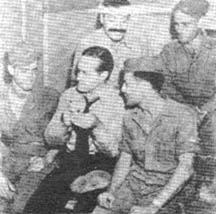 |
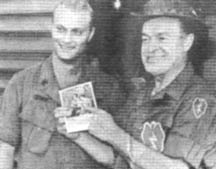 |
|
| FRANCE, 1944 - Bob Hope autographs a souvenir for Harry L. McNeer, Jr., right, then a First Lieutenant in the U.S. Army. | VIETNAM 1968 - Bob Hope and Specialist 4 Harry L. McNeer III look at a photo of Hope autographing a souvenir for McNeer's father in France in 1944. |
Mole
City Attack...
(Continued
from Page 1)
"They
did a real fine job. You name it
and we had it out there, everything except the B-52s."
"The NVAs were wearing new
uniforms and looked well fed. The
enemy was armed with brand new weapons and looked like they had come to put up a
fight," said Colonel Robert L. Fair, Tropic Lightning's 1st Brigade
commanding officer from San Francisco, Calif.
"Once they started the
attack, we really gave them h—! We
put in about 650 rounds of 155 (howitzer) from Bravo Battery of the 3d of the
13th Artillery located at Fire Support Base Austin, six miles to the east, and
the local ARVNs fired approximately 400 rounds of 105 (howitzer) for us.
In addition we put in eight air strikes on them, used five spookies and
two light fire teams."
"In my 26 years of
service," continued Fair, "I've never seen a fight like this one."
Every trick in the book was used against what was believed to be the
regimental raid on Patrol Base Mole.
Thanks to
Mack D. Gooding, 15th PID, 1st Bde., for sharing this issue,
Kirk Ramsey, 2nd Bn., 14th Inf. for creating this page.
This page last modified 8-12-2004
©2004 25th Infantry Division Association. All rights reserved.